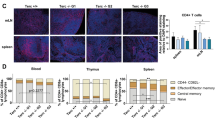Abstract.
Increasing generations of the telomerase knockout mouse, Terc–/–, show severe telomere dysfunction characterized by critically short telomeres and end-to-end chromosomal fusions. These mice also suffer from various age-related diseases affecting highly proliferative tissues. Among these pathologies are a reduced proliferative capacity of B and T cells, as well as a reduction of germinal center reactivity upon immunization. Both immune system defects are landmarks of immunosenescence. The study of the telomerase-deficient mouse model supports the notion that telomere shortening with age contributes to immunological dysfunction in the elderly.
Similar content being viewed by others
Author information
Authors and Affiliations
Rights and permissions
About this article
Cite this article
Blasco, M. Immunosenescence phenotypes in the telomerase knockout mouse. Springer Semin Immunopathol 24, 75–85 (2002). https://doi.org/10.1007/s00281-001-0096-1
Issue Date:
DOI: https://doi.org/10.1007/s00281-001-0096-1




